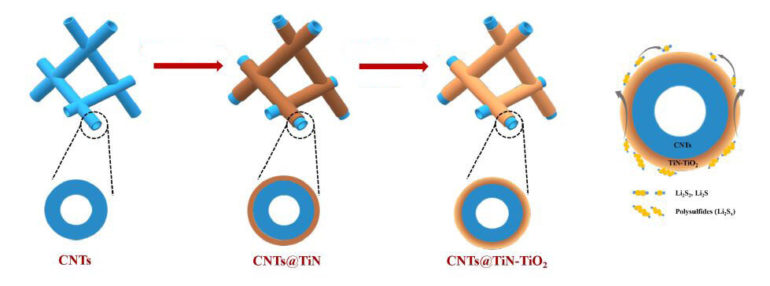Rechargeable batteries are a necessity to meet the world’s growing energy demands in a sustainable fashion, but not all are equal. Researchers in the Energy Materials and Surface Sciences Unit at the Okinawa Institute of Science and Technology Graduate University have worked to optimize a promising candidate of such energy sources—lithium sulfur batteries. The study was published in Nature Communications.
“Lithium sulfur batteries can store more energy than the lithium ion batteries that are already commercially available,” said Dr. Hui Zhang, first author of this study. “To put this in numbers, an electric vehicle that runs on lithium ion batteries can drive an average of 300km before it needs to be charged. With the improved energy storage provided by lithium sulfur batteries, it should be possible to extend this to 500km.”
The main challenge that has prevented lithium sulfur batteries from becoming commercialized is that the intermediate product is susceptible to dissolving. During the construction of the battery, the sulfur will react with the lithium to form a product. There are two stages to this. In the first stage, the product will be lithium polysulfide, which can easily dissolve into polysulfides. If this happens, the polysulfides will impair the performance of the battery, resulting in its lifespan being greatly reduced. To optimize the batteries, the lithium polysulfide needs to transform to the final product, either Li2S2 or Li2S, as quickly as possible. To do this, the researchers utilized two different materials—TiO2, which absorbs the unwanted polysulfides, and TiN, which accelerates the process.
“Using these two materials, we developed a hybrid that is low cost and easy to apply,” said Dr. Luis Ono, second author of this study. “We found that it had an excellent ability to improve the battery performance.”
These materials are very sensitive. To maximize the battery’s efficiency, the researchers worked on the scale of nanometers. They found that 10nm of TiN and 5nm of TiO2 created the most efficient product. With the polysulfides being absorbed and the whole process being accelerated, the batteries performance was greatly improved. This translated to a shorter charging time, a longer life between charges, and a greater overall lifespan. To establish this, the researchers ran the battery for 200 cycles and found that its efficiency was almost the same.
“We will continue to further optimize the materials to improve the performance,” said Professor Yabing Qi, senior author of the study and head of the Energy Materials and Surface Sciences Unit at OIST. “There are a lot of brilliant minds working on lithium sulfur batteries and it’s a really promising and exciting technology.”
Novel heterostructure nanosheet boosts efficiency of lean-electrolyte lithium batteries
More information:
Hui Zhang et al, Long-life lithium-sulfur batteries with high areal capacity based on coaxial CNTs@TiN-TiO2 sponge, Nature Communications (2021). DOI: 10.1038/s41467-021-24976-y
Provided by
Okinawa Institute of Science and Technology
Citation:
Speed and absorption key to optimizing a new type of rechargeable battery (2021, August 6)
retrieved 6 August 2021
from https://techxplore.com/news/2021-08-absorption-key-optimizing-rechargeable-battery.html
This document is subject to copyright. Apart from any fair dealing for the purpose of private study or research, no
part may be reproduced without the written permission. The content is provided for information purposes only.
